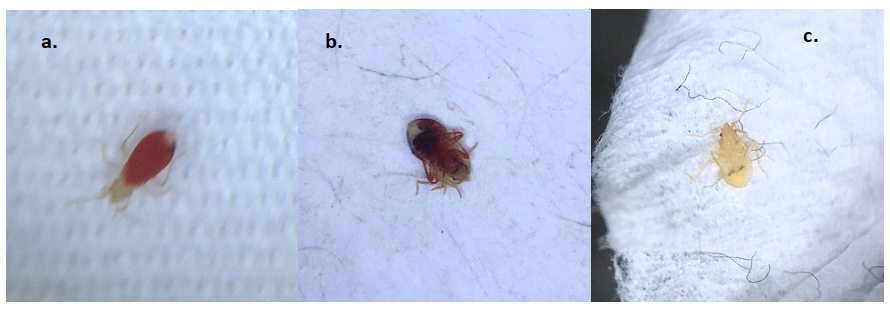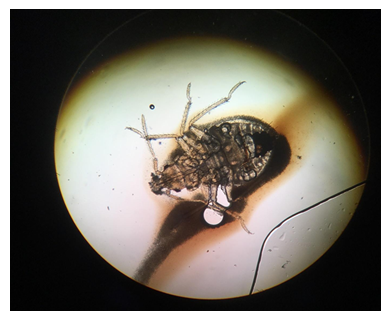Severe Iron Deficiency Anemia Caused by Long-lasting Bedbug Infestation
Anna Kenyeres*,1, Imre L Szabo2, Emese Badon3, Arpad Illes1 and Adam Jona1
1Faculty of Medicine, Department of Hematology, University of Debrecen, Debrecen, Hungary, Doctoral School of Clinical Medicine, University of Debrecen, Debrecen, Hungary
2Faculty of Medicine, Department of Dermatology, University of Debrecen, Debrecen, Hungary
3Faculty of Medicine, Department of Pathology, University of Debrecen, Debrecen, Hungary
*Corresponding author: Anna Kenyeres, Faculty of Medicine, Department of Hematology, University of Debrecen, Debrecen, Hungary, Doctoral School of Clinical Medicine, University of Debrecen, Debrecen, Hungary
Received: 24 June 2025; Accepted: 06 July 2025; Published: 12 August 2025
Article Information
Citation: Anna Kenyeres, Imre L Szabo, Emese Badon, Arpad Illes and Adam Jona. Severe Iron Deficiency Anemia Caused by Long-lasting Bedbug Infestation. Fortune Journal of Health Sciences. 8 (2025): 778-781.
View / Download Pdf Share at FacebookAbstract
Background: Iron deficiency anemia is a common finding in doctors’ practice. The background of iron deficiency should always be carefully investigated to find the underlying cause.
Case presentation: We present a case where investigations did not reveal mucosal blood loss or absorption insufficiency, and a relatively uncommon cause - excessive bedbug infestation - was recognized.
Conclusion: We summarize the literature on the co-occurrence of severe bedbug infestation and iron deficiency anemia.
Keywords
iron deficiency anemia; bedbug
Article Details
Introduction
Iron deficiency is one of the most common findings in doctors’ practice. The prevalence depends on the population studied. Iron deficiency has three stages, depending on the presentation and severity of anemia. Low ferritin level is the first laboratory finding in iron deficiency, which further decreases with the progression of iron depletion, when also low serum iron level, low percent saturation of transferrin, increased total iron binding capacity present, and microcytic hypochromic anemia develops. As it is not a separate disease, the cause of the iron deficiency and iron deficiency anemia (IDA) always requires further investigation [1]. Generally, the mechanism of IDA is the imbalance between iron intake and consumption. Latter is either caused by increased iron demand or by iron loss, presenting as overt or occult bleeding. Decreased iron intake in adults usually occurs in vegetarians because non-heme iron, presented in plants, is worse absorbed than heme iron in meat [2]. In childhood, lack of iron supplements in breastfed infants, insufficient iron-rich complementary foods, and excessive intake of cow’s milk are the most common causes of decreased iron intake [3]. Iron is absorbed in the upper gastrointestinal tract, and the duodenum is the site of maximum absorption. The acidic gastric environment facilitates the absorption of iron. Diseases (celiac disease, atrophic gastritis, H. pylori infection), interventions (bariatric surgery), and medications (PPI) affecting the function of this site of the gastrointestinal tract can disturb normal iron absorption. Increased iron demand physiologically presents in childhood when rapid growth and increase in body muscle mass happens, and it also develops in pregnancy and during the breastfeeding period [4]. Major causes of chronic iron loss are underestimated heavy menstrual bleeding and occult gastrointestinal or urinary tract bleeding. Still, regular blood donation, gastrointestinal parasites, or intravascular hemolysis (e.g., paroxysmal nocturnal hemoglobinuria) can also result in IDA [1]. This report presents a case where investigations excluded the most common causes of iron deficiency anemia, and a relatively uncommon cause was recognized.
Case presentation
A 78-year-old female patient was hospitalized for dyspnea, worsening for weeks. The patient's history reveals hypertension, ischaemic heart disease, deep vein thrombosis, and lifelong anticoagulation because of permanent atrial fibrillation. She was admitted to the hospital and assessed for iron deficiency anemia eight months before her current hospitalization. The hemoglobin level at presentation was 50 g/l (normal range is above 115 g/l in women), RBCs were microcytic (MCV 61.9 fL, normal range 80-99 fL), and hypochromic (MCH 16.7 pg, normal range 27-31 pg). The iron level was 2.3 umol/l (normal range 6.6-26.0 umol/l), and the ferritin level was 16.3 ug/l (normal range 30-400 ug/l). According to ambulance documentation, there was a massive amount of bedbugs in the patient’s home. Physical examination revealed erythematous, pruritic macules with central hemorrhagic puncta in linear and grouped distribution on the arms, chest, abdomen, and legs (Figure 1a-d). Urinary tract infection was present with non-significant germ count, nor signs of systemic infection or microscopic hematuria.
There was no sign of vaginal bleeding. However, the fecal blood test was negative several times. Both upper and lower gastrointestinal endoscopic examinations were performed to exclude blood loss from the GI tract. Gastroscopy was negative, and colonoscopy revealed colon diverticulosis, which did not explain the severe anemia, according to the gastroenterologist. Iron absorption was appropriate. According to the patient, the bedbug infestation lasted for months, and there were unsuccessful attempts to exterminate the parasites, affecting the whole building with about 60 apartments. With the exclusion of mucosal blood loss and abnormal absorption, we think that the severe iron deficiency anemia of the patient was caused by long-lasting, severe bed bug infestation and bites. A repeated attempt of insect control was organized with moderate effect. The patient did not go to lab control. Seven months later, she was hospitalized again because of weakness and worsening dyspnea. At this time, the hemoglobin level was 28 g/l, multiple excoriations and sites of bites were seen on the patient’s skin, and she presented with signs of cardiac decompensation. Unfortunately, despite the local treatment of bites, blood transfusions, intravenous iron supplementation, and best supportive care, the patient died on the fourth day of hospitalization. The autopsy confirmed severe universal arteriosclerosis and ischaemic cardiomyopathy without acute arterial occlusion and ruled out the presence of malignant disease or any other cause of blood loss.
Discussion
Bed bugs are obligate hematophagous insects belonging to the Cimicidae family. Two species feed primarily on humans. Cimex lectularius (Figure 2a-c and 3) – also known as the common bed bug - is predominant in temperate regions, while Cimex hemipterus is referred to as a tropical bed bug, frequently reported in Southeast Asia, Africa, and Australia [5, 6]. Although these pests have a long association with humans, there was a period from the 1950s until the 1980s when bed bug infestations became relatively uncommon. However, since the 1990s, there has been a significant resurgence in the number of infestations globally [5-7]. Classically, bed bugs are considered benign, as there has not been one proven case of bed bugs transmitting any infectious agent [7,8]. Although direct health impacts of bed bugs are considered fairly minimal [7], they can be underestimated, as, besides clinical issues, the presence of bed bugs in an infested location may occasionally lead to systemic and psychological disorders [6,7].
Figure 2a-c: These specimens may not look alike at first glance. However, they all belong to the same Cimex lectularius (common bedbug) specimen. Their tiny (1.5 mm) eggs may be seen around highly-visited beds. Once they hatch, they evolve to the adult (picture 2b) phase through 5 distinct nymph stages when their morphology slightly changes, and they grow in size. Their appearance also fundamentally depends on their feeding status, after feeding on human blood or before consumption. Note the difference in their morphology when their intestines contain visible blood (picture 2b) or when empty (picture 2c).
Bed bugs usually do not live on the human body, and the contact restricts blood meal, typically occurring at night, between 1 and 5 a.m., when people sleep most deeply [7]. Therefore they are rarely seen upon examination of infested patients. The diagnosis of a bedbug infestation is based on the clinical history and the appearance of bites. Signs of bites are accompanied by variable cutaneous reactions. Initially, erythematous, pruritic macules are common and can be followed by subsequent papules and vesicles. Bullae, nodules, and secondary infections can also develop. These reactions are self-limited and can resolve within one or two weeks without any specific treatment [5]. Other evidence may consist of the exoskeleton of bugs and blood-tinged feces, which can be found in the sleeping quarters of the patient. Cracks of furniture, electrical boxes, carpets, bed frames, mattresses, and linens must be checked with special attention, as these pests are photophobic and hide in the daytime [5, 7]. There are limited case reports of bedbugs causing transfusion-demanding anemia. Typically, patients presented with very severe anemia, with hemoglobin levels below 60 g/l in most cases [8-11]. Severe, long-lasting infestations occur most probably in patients with cognitive impairment with lost autonomy. In two cases, infested patients performed poorly on Mini Mental State Examination [8, 10]. The bites can be more extended, and the anemia can be more severe in patients who sleep deeply. It is physiologically presented in children [12] but also affects adults with the use of sedatives or in case of alcohol and drug abuse [9, 10]. Unusual expansion of the parasite in the patient’s clothes [8] and massive colonization of a patient’s leg prosthesis was described [11] as the source of severe infestation. There are a few observations when bed bugs were found on the patient’s body [10], although they are photophobic and usually have their blood meals during the night and return to their hiding places, which are preferentially within a few meters of their host [11]. This can be related to excessive alcohol consumption. Sheele et al. analyzed data from emergency departments between 2011 and 2017. Parameters of bed bug-infested patients were compared with non-infested control patients. Results revealed that infested patients had significantly lower hemoglobin levels and mean corpuscular hemoglobin concentrations. The presence of severe anemia (hemoglobin level below 70 g/l) was significantly higher in infested than in non-infested patients (4.4% vs. 0.7%, respectively) [13].
Conclusion
Patients with IDA have to be carefully investigated, looking for all potential cause of this symptom. Therefore, accurate physical examination and environmental history-taking are essential. Bedbug infestation is a rare cause of iron deficiency anemia, but the social and health impact is underestimated. Patients with cognitive impairment, sedative use, and alcohol or drug abuse are at higher risk for developing severe anemia. We think anticoagulation can aggravate the severity, but there is no data about it in the literature.
Conflict of interest statement
The authors have declared that no competing interests exist.
References
- Camaschella C. Iron-deficiency anemia. N Engl J Med 372 (2015): 1832-43.
- Pawlak R, Berger J, Hines I. Iron Status of Vegetarian Adults: A Review of Literature. Am J Lifestyle Med 12 (2016): 486-498.
- Baker RD, Greer FR; Committee on Nutrition American Academy of Pediatrics. Diagnosis and prevention of iron deficiency and iron-deficiency anemia in infants and young children (0-3 years of age). Pediatrics 126 (2010): 1040-50.
- Camaschella C. Iron deficiency: new insights into diagnosis and treatment. Hematology Am Soc Hematol Educ Program (2015): 8-13.
- Studdiford JS, Conniff KM, Trayes KP, et al. Bedbug infestation. Am Fam Physician 86 (2012): 653-8.
- Chebbah D, Elissa N, Sereno D, et al. Bed Bugs (Hemiptera: Cimicidae) Population Diversity and First Record of Cimex hemipterus in Paris. Insects 12 (2021): 578.
- Doggett SL, Dwyer DE, Peñas PF, et al. Bed bugs: clinical relevance and control options. Clin Microbiol Rev 25 (2012): 164-92.
- Sabou M, Imperiale DG, Andrès E, et al. Bed bugs reproductive life cycle in the clothes of a patient suffering from Alzheimer's disease results in iron deficiency anemia. Parasite 20 (2013): 16.
- Pritchard MJ, Hwang SW. Cases: Severe anemia from bedbugs. CMAJ 181 (2009): 287-8.
- Izri A, Marteau A, Ferreira T, et al. Severe anemia due to bed bugs hyperinfestation. Microb Pathog 149 (2020): 104564.
- Paulke-Korinek M, Széll M, Laferl H, et al. Bed bugs can cause severe anaemia in adults. Parasitol Res 110 (2012): 2577-9.
- VENKATACHALAM PS, BELAVADY B. Loss of haemoglobin iron due to excessive biting by bed bugs. A possible aetiological factor in the iron deficiency anaemia of infants and children. Trans R Soc Trop Med Hyg 56 (1962): 218-21.
- Sheele JM, Pritt BS, Libertin CR, et al. Bed bugs are associated with anemia. Am J Emerg Med 46 (2021): 482-488.





 Impact Factor: * 6.124
Impact Factor: * 6.124 Acceptance Rate: 76.33%
Acceptance Rate: 76.33%  Time to first decision: 10.4 days
Time to first decision: 10.4 days  Time from article received to acceptance: 2-3 weeks
Time from article received to acceptance: 2-3 weeks 